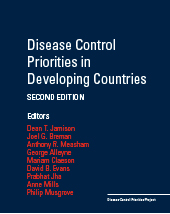أولويات مكافحة المرض في الدول النامية (كتاب)
 | |
| المؤلف | |
|---|---|
| اللغة | إنجليزية |
| الموضوع | طب |
| نوع أدبي | علمي |
| الناشر | البنك الدولي |
| الإصدار | 2006 |
| عدد الصفحات | 1440 |
| تعديل | |
كتاب أولويات مكافحة المرض في الدول النامية، Disease Control Priorities in Developing Countries, 2nd edition من منشورات البنك الدولي عام 2006. يتألف الكتاب من 1440 صفحة ، يتناول فيه الجهود العالمية لمكافحة المراض وأين نجحت وما هي الأولويات التي يجب العمل عليها ، وكيف تجرى أفضل التعاملات الصحية بأقل الكلف، وكيف يتم التكامل بين مختلف القطاعات كالماء والزراعة والصرف الصحي والتعليم للوصول إلى تحسين أمثل للصحة العامة.
فصول الكتاب
1. Investing in Health الاستثمار في الصحة النص
2. Intervention Cost–Effectiveness: Overview of Main Messages نظرة عامة على المسائل الرئيسية للكفاءة الاقتصادية للإجراءات النص
3. Strengthening Health Systems تقوية الأنظمة الصحية
4. Priorities for Global Research and Development of Interventions أولويات الأبحاث العالمية وتطوير الإجراءات
5. Science and Technology for Disease Control: Past, Present, and Future العلم والتقنية لمكافحة المرض بين الماضي والحاضر والمستقبل 6. Product Development Priorities أولويات تطوير المنتج
7. Economic Approaches to Valuing Global Health Research المقاربات الاقتصادية لتقييم الأبحاث الصحية العالمية 8. Improving the Health of Populations: Lessons of Experience دروس من الخبرة في تحسين صحة الجمهور 9. Millennium Development Goals for Health: What Will It Take to Accelerate Progress? لأهداف التنمية الصحية الألفية وما الذي يلزمنا لتسريع التقدم 10. Gender Differentials in Health الفروق بين الجنسين صحياً
11. Fiscal Policies for Health Promotion and Disease Prevention السياسات المالية للترويج الصحي والوقاية من المرض 12. Financing Health Systems in the 21st Century تمويل الأنظمة الصحية في القرن الحادي والعشرين
13. Recent Trends and Innovations in Development Assistance for Health التوجهات الحالية والإبتكارات في تطوير الدعم الصحي
14. Ethical Issues in Resource Allocation, Research, and New Product Development
15. Cost–Effectiveness Analysis for Priority Setting تحليل الكفاءة الاقتصادية لتحديد الأولوية
16. Tuberculosis السل
17. Sexually Transmitted Infections الأمراض المنقولة جنسياً
18. HIV/AIDS Prevention and Treatment وقاية وعلاج من مرض الإيدز وفيروسه
19. Diarrheal Diseases أمراض الإسهال
20. Vaccine–Preventable Diseases الأمراض المتقاة بالتلقيح (التطعيم)
21. Conquering Malaria مكافحة الملاريا
22. Tropical Diseases Targeted for Elimination: Chagas Disease, Lymphatic Filariasis, Onchocerciasis, and Leprosy
23. Tropical Diseases Lacking Adequate Control Measures: Dengue, Leishmaniasis, and African Trypanosomiasis
24. Helminth Infections: Soil–Transmitted Helminth Infections and Schistosomiasis
25. Acute Respiratory Infections in Children
26. Maternal and Perinatal Conditions
27. Newborn Survival
28. Stunting, Wasting, and Micronutrient Deficiency Disorders
29. Health Service Interventions for Cancer Control in Developing Countries
30. Diabetes: The Pandemic and Potential Solutions
31. Mental Disorders
32. Neurological Disorders
33. Cardiovascular Disease
34. Inherited Disorders of Hemoglobin
35. Respiratory Diseases of Adults
36. Diseases of the Kidney and the Urinary System
37. Skin Diseases
38. Oral and Craniofacial Diseases and Disorders
39. Unintentional Injuries
40. Interpersonal Violence
41. Water Supply, Sanitation, and Hygiene Promotion
42. Indoor Air Pollution
43. Air and Water Pollution: Burden and Strategies for Control
44. Prevention of Chronic Disease by Means of Diet and Lifestyle Changes
45. The Growing Burden of Risk from High Blood Pressure, Cholesterol, and Bodyweight
46. Tobacco Addiction
47. Alcohol
48. Illicit Opiate Abuse
49. Learning and Developmental Disabilities
50. Loss of Vision and Hearing
51. Cost–Effectiveness of Interventions for Musculoskeletal Conditions
52. Pain Control for People with Cancer and AIDS
53. Public Health Surveillance: A Tool for Targeting and Monitoring Intervention
54. Information to Improve Decision Making for Health
55. Drug Resistance
56. Community Health and Nutrition Programs
57. Contraception
58. School–Based Health and Nutrition Programs
59. Adolescent Health Programs
60. Occupational Health
61. Natural Disaster Mitigation and Relief
62. Control and Eradication
63. Integrated Management of the Sick Child
64. General Primary Care
65. The District Hospital
66. Referral Hospitals
67. Surgery
68. Emergency Medical Services
69. Complementary and Alternative Medicine
70. Improving the Quality of Care in Developing Countries
71. Health Workers: Building and Motivating the Workforce
72. Ensuring Supplies of Appropriate Drugs and Vaccines
73. Strategic Management of Clinical Services